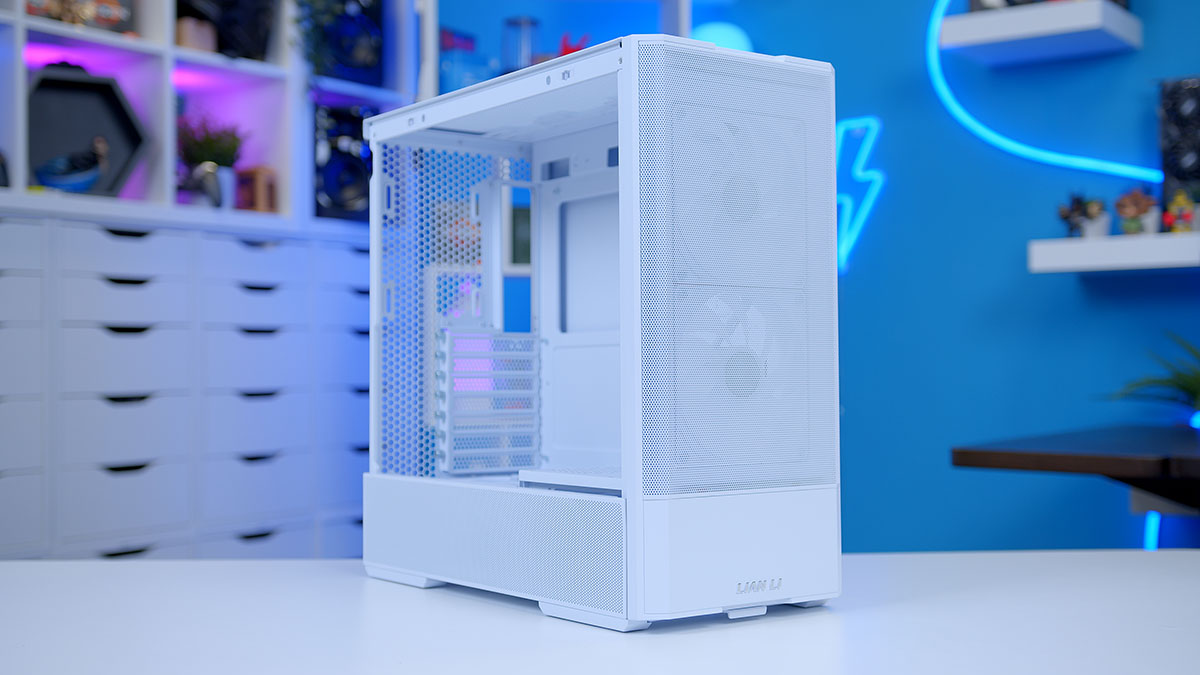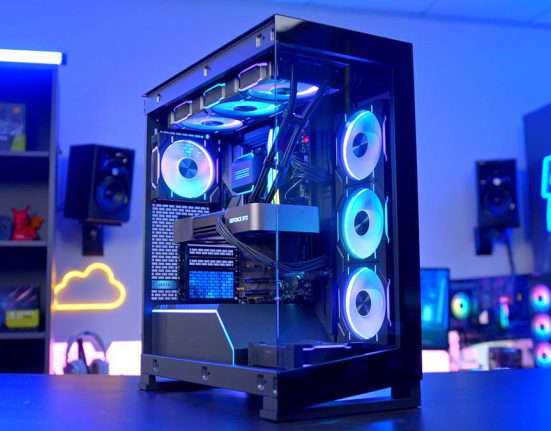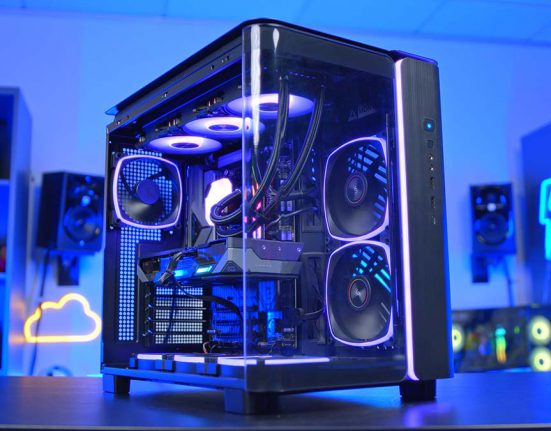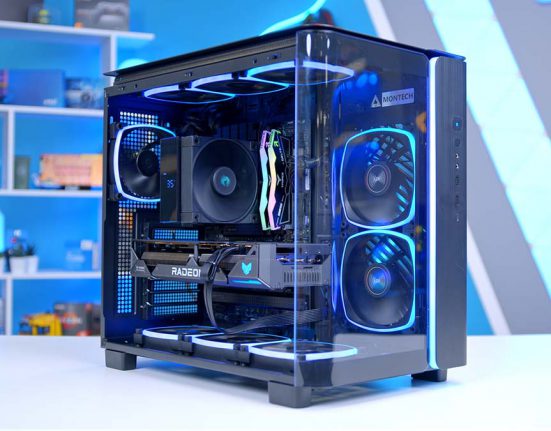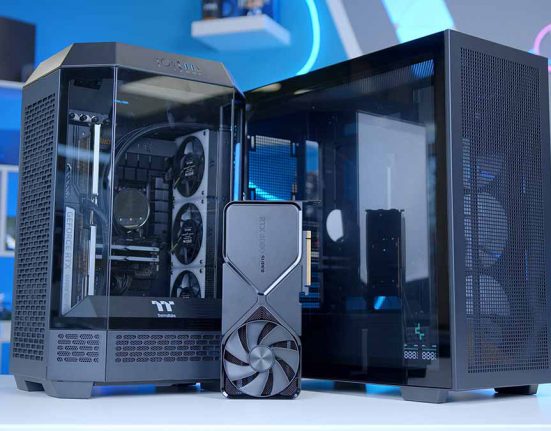The Lian Li LANCOOL 207 is a compact and affordable PC case that aims to provide compatibility with a wide range of components. To achieve this, the LANCOOL 207 takes an interesting approach, shifting the PSU mount to the front of the case. In addition, the LANCOOL 207 boasts a fully ventilated mesh front panel and four pre-installed fans designed to maximise airflow and cut costs. However, we will evaluate the LANCOOL 207 against other budget-oriented PC cases we’ve tested to assess the value proposition of this chassis.
Lian Li has built up a strong reputation for delivering high-quality PC cases over recent years, with the O11 Vision being considered a fan-favourite among PC building enthusiasts. Compared to other Lian Li chassis that we’ve previously reviewed and built with, the LANCOOL 207 is positioned at the lower end of the market. So, we’re excited to see another budget entrant from Lian Li that opens up options for price-conscious buyers.
In this review, we’ll analyse the Lian Li LANCOOL 207’s design, features, and build quality to determine whether PC builders on a restricted budget should consider this chassis.
Specification
The Lian Li LANCOOL 207 is a fairly compact PC case with similar dimensions to the NZXT H5 Flow and Fractal Design Focus 2. Because of this, we’d expect this chassis to possess limited support for various components compared to larger mid-tower designs. However, the clearance and compatibility for components appear to align with the needs of modern PC parts, especially for those building a budget-focused system.

For example, the LANCOOL 207 can accommodate Mini-ITX, Micro-ATX, and ATX motherboards, allowing the vast majority of motherboards to be installed into this chassis without any issues. Whilst the absence of support for larger E-ATX motherboards means the LANCOOL 207 can’t cover all bases, these designs are often reserved for high-end gaming PC builds, which this case is simply not designed for.
In addition, the 180mm CPU cooler height is ideal for budget builds, as it offers plenty of room for powerful air coolers, which can get quite bulky. For those looking to invest in beefier cooling support, the LANCOOL 207 can accommodate a 360mm liquid cooler on the top panel.
| Key Specs | Lian Li LANCOOL 207 |
|---|---|
| Form Factor | Mid-Tower |
| Motherboard Support | Mini-ITX, Micro-ATX, ATX |
| Case Dimensions (L x W x H) | 455mm x 219mm x 456mm |
| Front IO | 1 x USB 3.1 Type-C 2 x USB 3.0 Type-A 1 x 3.5mm Audio Jack |
| PCI-E Slots | 7 |
| Colour | Black White |
| Max Clearance | 180mm CPU Cooler Height 375mm GPU Length 160mm PSU Length |
| Drive Support | Up to 2 x 3.5 inch Up to 2 x 2.5 inch |
| Fan Support | Front: 2 x 140mm Top: 3 x 120mm Bottom: 2 x 120mm Rear: 1 x 120mm |
| Radiator Support | Top: Up to 360mm |
| Pre-Installed Fans | 2 x 140mm 2 x 120mm |
| MSRP | LANCOOL 207 Black: $79.99 LANCOOL 207 White: $84.99 |
However, the GPU and PSU clearance on the Lian Li LANCOOL 207 does raise some concerns. With graphics cards seemingly getting bigger with each generation, the 375mm GPU length could cause clearance issues with upcoming generations from AMD and NVIDIA. Additionally, the 160mm PSU length will limit the selection pool for power supplies, as this will be a tight squeeze for many ATX PSUs.
In terms of connectivity, the front IO offers enough ports to easily connect several gaming peripherals and accessories to your gaming PC. Plus, the front IO includes a variety of ports, with a single USB 3.1 Type-C port, two USB 3.0 Type-A ports, and a 3.5mm Audio Jack, which means there’s no need for adapters or USB hubs.

As for pricing, the Lian Li LANCOOL 207 sits at an MSRP of $79.99 for the black version, with the price increasing to $85.99 for the white model. This puts this chassis comfortably within the lower end of the market. With the features and component support on offer, this seems to be a reasonable price point for the LANCOOL 207.
For comparison, this puts the Lian Li LANCOOL 207 at a similar price to the Corsair 3000D and Phanteks XT Pro Ultra. These two cases share a lot of similarities with the LANCOOL 207, especially when it comes to design and form factor, helping to justify its pricing. However, a major difference between the LANCOOL 207 and its close competition is the support for components, where it appears this case is lagging behind.
Lian Li LANCOOL 207 Design
At first glance, the design of the Lian Li LANCOOL 207 looks rather straightforward. With a mesh front panel, a tempered glass side panel, and ventilated top and rear panels, the outside of this chassis boasts a run-of-the-mill mid-tower design.
As a result, the aesthetic of this build is also kept simplistic, with a consistent black or white colour scheme based on the model selected. Though the combination of mesh and solid metal around the chassis forges a smart and marginally unique aesthetic, the LANCOOL 207 lacks the distinct design choices to stand out from the array of mid-tower PC cases available.

However, the inside of the chassis is where the LANCOOL 207 subverts expectations, offering a revised configuration that moves components around to maximise clearance and airflow. Most notably, the PSU mount has been relocated from the back to the front of the case, which lets the motherboard sit in a lower position and places the bottom fans directly underneath the GPU and motherboard.
In theory, these pre-installed fans will optimise airflow by pushing cool air directly onto the GPU, lowering the graphics card’s temperature at all times. Working in tandem with the two 140mm ARGB fans that come pre-installed with the case, as well as a CPU cooler, these fans ensure the LANCOOL 207 can provide ample cooling out of the box.

The pre-installed fans included with the LANCOOL 207 are very beneficial, as they eliminate the need to purchase additional fans for a build inside this case, saving a chunk of cash in the process. A lot of PC cases available at a similar price point will fail to provide any pre-installed fans, immediately lowering their value proposition.
The only downside of the pre-installed fans is that the two 120mm fans don’t include any RGB lighting, unlike the two 140mm fans located on the front panel. Because of this, RGB lovers may want to swap these fans out for RGB alternatives. The two pre-installed 140mm fans at the front of the case could be shifted to the top of the chassis to create a push-pull configuration with the bottom fans. But keep in mind, this is the only panel on the LANCOOL 207 that can accommodate liquid coolers

Overall, the Lian Li LANCOOL 207 features a simplistic design that offers excellent value. For first-time builders, the pre-installed fans will make the building process much easier, while the heavy ventilation throughout the design will maximise airflow. However, this simplicity comes at the expense of aesthetics and flexibility, which will deter more experienced builders from this design.
Building in the Lian Li LANCOOL 207
As a budget-friendly PC case, the Lian Li LANCOOL 207 must aim to provide a streamlined PC building experience, as many using this case will likely be first-time builders. And given the unorthodox internal layout of this chassis, it is important to understand whether these adjustments benefit or complicate the building experience.
To assess how easy it is to build a high-quality gaming PC inside of the Lian Li LANCOOL 207, we’ll be taking a closer look at the aspects of this case that will have a major influence on its functionality, such as internal space and mounting hardware, along with pointing out any other design choices which may help or hinder PC builders.
Internal Space
The internal space on the Lian Li LANCOOL 207 is somewhat of a mixed bag. In some areas, this case is very considerate and takes extra care to accommodate larger components.

The cooling support is a prime example, as the 180mm CPU cooler height provides enough clearance to support high-end air coolers, which are often used in budget-oriented systems. In addition, relocating the PSU allows the motherboard to be shifted down slightly, making room for thicker radiators to be installed into the case without conflicting with other components.
However, this comes at the expense of other components, such as the GPU and PSU, which are given restricted clearance compared to similar mid-tower designs. Whilst the 375mm of GPU clearance should be enough to keep most budget and mid-range graphics cards performing as intended, high-end graphics cards will be challenging to install. Similarly, the 160mm PSU clearance is relatively small, limiting compatibility with more high-end PSUs.

Positioning the PSU at the front of the case comes with its own set of benefits and challenges. Compared to the conventional PSU orientation, the power supplies used in this case need to be pushed to the front and rotated 90 degrees. As a result, the power switch will be located on the left side of the case, whilst the connector ports are located on the right.

The positive is that this makes the ports easier to access, speeding up cable management. When used alongside the included cable ties, grommets, and routing cutouts, novice builders should have no issues making their PC builds look clean and tidy. On the other hand, the new location makes it harder to access the power switch, as it is covered by a mesh panel. Lian Li does provide a workaround in the form of a PSU power adapter that connects to the rear of the case, but this seems finicky and less reliable than direct access to the power switch.
Radiator & Fan Mounting
Cooling is one of the LANCOOL 207’s biggest strengths, with the vast amount of ventilation and pre-installed fans offering high-end airflow out of the box. Because of this, it’s no surprise that the cooling support is quite extensive.
As mentioned earlier, the LANCOOL 207 comes with four pre-installed fans: two 120mm and two 140mm. This drastically simplifies the PC building process, as installing additional fans can often be one of the most time-consuming steps when assembling a gaming PC. By default, the two 120mm fans are installed along the bottom, while the two 140mm fans are positioned at the front.

Honestly, there isn’t much need to rearrange these fans, as their default positions are arguably the most viable slots. We recommend adding a rear fan as an exhaust to work alongside your CPU cooler, but there’s not much reason to adjust the pre-installed fans, as they’ll be used to pull cool air into the case.
Fortunately, the LANCOOL 207 provides support for various CPU coolers. With 180mm clearance for CPU coolers, the LANCOOL 207 has no issues supporting most air CPU coolers, with the standard fan configuration being a suitable setup for an air-cooled system.

This case also supports up to 360mm AIO coolers, with the lower position of the motherboard opening up space for thicker radiators and push-pull radiator configurations to maximise heat dissipation. However, this comes with a few caveats, as they can only be installed at the top of the chassis and may interfere with a rear-mounted fan or the motherboard.
Ease of Building
Overall, the Lian Li LANCOOL 207 is a relatively simple case to build in, with varying mileage depending on the type of PC you wish to assemble. For example, those building an air-cooled system or one that takes advantage of a push-pull radiator will find building in the LANCOOL 207 straightforward.

With plenty of fans pre-installed, tool-less mechanisms for each panel, and a built-in cable management system, this case offers the tools needed for a hassle-free PC build. On top of this, features such as easy access to the PSU chamber and a GPU support bracket provide quality-of-life improvements that are often missing on budget chassis.

That being said, those looking for more adaptability and customisation when building their gaming PC will be left disappointed, as the LANCOOL 207 certainly shepherds you towards specific configurations. Restricting the radiator support to the top of the case makes it difficult to take advantage of all the fan slots with a liquid AIO, and the combination of RGB and non-RGB pre-installed fans will likely cause some builders to swap at least one set of these fans out for a more cohesive aesthetic.
Features We Like
GPU Support
An incredibly useful feature included in the LANCOOL 207 is an integrated GPU support bracket, as it ensures your graphics card is aligned perfectly and prevents GPU sag. The support is very easy to adjust as it is secured by a single screw that attaches the bracket to one of three slots on the chassis. Each slot caters to various sizes of GPU, ranging from 285mm to 375mm in length.

Ventilation & Airflow
Like many budget-oriented chassis, the LANCOOL 207 puts a heavy emphasis on cooling and ventilation. With plenty of vents on each panel, four pre-installed fans and sufficient space for high-end air and liquid CPU coolers, this case should have no issues keeping the temperatures of any gaming PC in check. On top of this, the unique layout of this case is specifically designed to maximise airflow, as the bottom fans can now be placed directly below the GPU without being obstructed by the power supply.

Features We Don’t Like
GPU and PSU Clearance
One of the biggest weaknesses of the LANCOOL 207 comes from one of its most interesting design choices. While moving the PSU to the front of the chassis does improve airflow, placing two fans alongside creates less room for the PSU, which means larger devices won’t fit in this case. In addition, the new position restricts direct access to the power switch, with builders being forced to rely on an adapter cable instead.

Another issue that comes more as a result of the compact design of this case is the limited GPU support. Granted, the 375mm of GPU clearance gives the LANCOOL 207 enough space to house most modern graphics cards with minimal concerns, we’d prefer to see at least 400mm of clearance, as this will guarantee that the chassis is well-equipped to support future GPU upgrades.
Limited Radiator Compatibility
The overall cooling support on the LANCOOL 207 is rather impressive, which makes the limited support for liquid CPU coolers more perplexing. With support for 240mm, 280mm, and 360mm AIOs, this case can accommodate most liquid CPU coolers on the market. However, these coolers can only be placed at the top of the chassis, which means the LANCOOL 207 lacks the freedom and adjustability provided by a wide range of cases with a similar layout, some of which are available for a similar price point.

Conclusion
Lian Li LANCOOL 207 Review
Product Name: Lian Li LANCOOL 207
Brand: Lian Li
SKU: LANCOOL 207
-
Features
-
Design
-
Versatility
-
Value for Money
Summary
Overall, the Lian Li LANCOOL 207 is a solid choice for novice builders looking to build an affordable gaming PC that maximises airflow. This case includes several features that help streamline the PC building process while ensuring the build performs at its best when switched on. For example, the inclusion of four pre-installed fans is a massive bonus on a PC case at this price point, as it reduces the number of steps for a PC build, keeps costs low, and guarantees improved cooling performance out of the box.
However, these functional features typically come at the expense of others. To keep costs down, this case includes a simplistic design lacking any individuality or wow factor. On top of this, many of the unique aspects of this case lead to issues elsewhere, such as the front-mounted PSU which restricts direct access to the power switch.
For first-time builders looking for a cheap chassis that will make building a PC as simple as possible, the LANCOOL 207 is worth considering. But for everyone else, I don’t think it will be too difficult to find a better option elsewhere.
Pros
✅ Airflow
✅ Pre-installed fans
✅ Simple building process
Cons
❌ Lacklustre aesthetic
❌ Clearance issues
❌ Limited customisation


